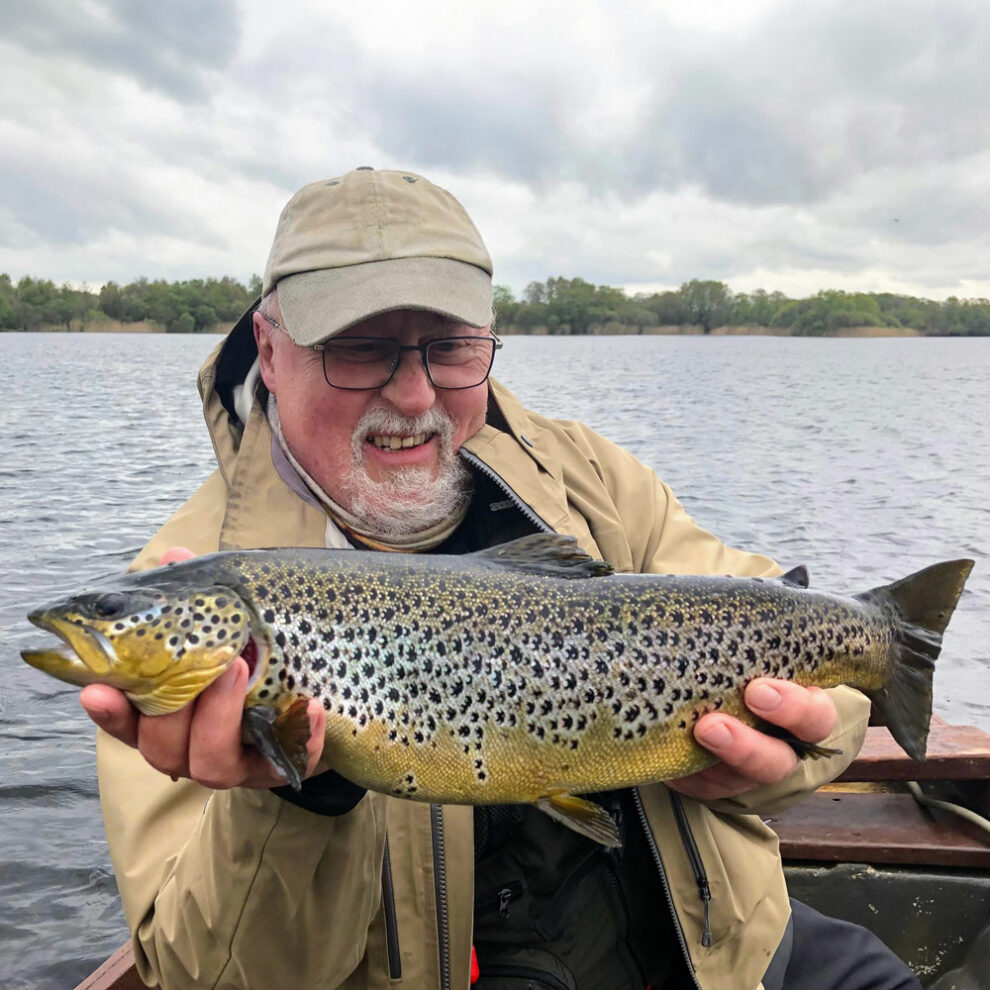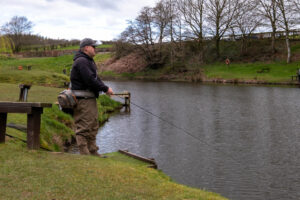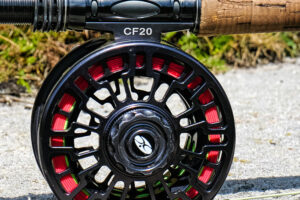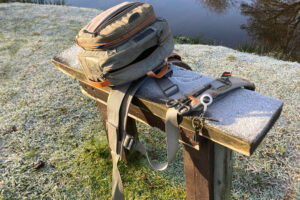Chris Paris
We often read about somebody catching “the fish of a lifetime”. Does this mean one special fish which stands out dramatically above all the other fish you ever caught, or is it all the memorable fish of an angler’s lifetime? Or some of them?
The expression “the fish of a lifetime” is often used to refer to an exceptional specimen, such as the huge brown trout that featured in an Angling Ireland weekly report on 30 September 2023. “Edmund Corry and Mike O’Shea fished Lough Mask yesterday and managed to end the season with a fish of a lifetime” Monster Trout on Size 10 Fly From Lough Mask.
The photos illustrating the report showed a delighted Edmund holding his enormous fish, estimated to be 17 to 19lb, and returning it gently to the water. That fantastic trout took a size 10 wet mayfly on a 10lb tippet, fished on a 6-weight intermediate line. This remarkable capture was made even more special because the fly had been tied by Edmund’s friend Mike Killen.
It’s hard to imagine that Edmund or anybody else could ever catch a more special and memorable fish, though three other captures that I’ve heard about recently run it pretty close. One was a 30lb pike caught on a fly in Northern Ireland last year by a young angler on only his third trip fly fishing for pike. The second was a pike of 44.5lbs caught on a sea deadbait in February this year from Chew Valley Lake in England, and the third was an 18lb barbel from the Somerly Estate stretch of the Hampshire Avon just three days ago.
If you could pick just one of these three fish, or Edmund’s whopper from Lough Mask, which would be your fish of a lifetime? That’s a hard question to answer, for me at least because I enjoy all types of fishing, though it is probably much easier for somebody who only fishes for trout to select Edmund’s Lough Mask trout. A barbel devotee may only be interested in the specimen from the Hampshire Avon. But I suspect that some pike anglers would have difficulty choosing between a 30-pounder on a fly and a 40-pounder on bait.
There’s a much easier way of defining “the fish of a lifetime” – just list all the memorable fish you’ve ever caught, like Al Van Vooren in Fish of a Lifetime or Phill Williams’s Ultimate Angling Bucket List.
One enthusiast, Ross Johnson, “The Mobile Angler 1000”, has set himself the goal of catching 1000 different species of fish. But how could anyone list their most memorable fish of a lifetime from 1000-plus different species? I struggled to get my list down to three in the Carpenters Arms pub in Somerset a few years ago after a day fishing Chew Valley Lake with John Horsey.
Peter O’Connell, John’s client the next day, asked me to name my three best-ever fish. “No problem”, I said, and the first two were easy: my biggest wild brown trout on a dry fly in New Zealand, and a huge South Australian kingfish which beat me up for 45 minutes. But I never got to number three, as there were too many possibilities to make up my mind. My head started spinning, so I gave up and had another pint of Butcombe bitter.
It got harder still to draw up a short-list of three best-ever fish when I wondered if the Kiwi trout and South Australian kingfish were really my two best-ever fish, or were they just more recent. One of the good things about going fishing a lot and living into your seventies is that you somehow manage to catch a lot of fish over the years. How did my Kiwi trout and Aussie kingfish rank when compared to my first-ever big roach or carp in the 1960s, my biggest Loch Lomond pike, my first trout on a dry fly, my biggest barbel, or some of the fabulous saltwater fish that I’ve caught on fly over the last fifteen years?
My friend Roger Baker suggested that I should simply list 20 to 30 fish that are still memorable as my life nears its end and say how they mark out my lifetime. Looking at it like that, I decided that there can’t be a single universal measure of “the” fish of a lifetime, whether one or many, as all fishing lives and preferences are unique, lived within diverse angling cultures, and interwoven with our “other” lives in various mixtures of design, chance, and opportunities.
The first Covid lockdowns gave me plenty of time to draw up a list of candidates for my 20-30 most memorable fish over the last sixty years. I also started thinking about all the people I’d fished with, how some of them had been important in my angling career, and listing as many as I could think of.
I’d just about managed to trim the list of the most memorable fish of my lifetime down to about 50 in March 2020 when I started writing my fishing book, The Fish of a Lifetime. After much agonising, I eventually decided that I couldn’t get the list down below 40, and that would give me more than enough to write about while we were all locked up by Boris and his scientific advisors. All attempts to cut it down below 40 only got my head spinning, as it did in the Carpenter’s Arms when Peter O’Connell asked me to pick my three best-ever captures.
Some of the fish of my lifetime stand out due to their significance in my angling career, from early specimens of target species in the 1960s and 1970s (specimen roach, tench, carp, and pike) to “firsts” of desirable species (20lb cod, wild brown trout on fly), bass, through to notable recent “bucket list” captures, including tuna and barramundi on fly in Australia, my biggest Lough Erne trout on a dry and a huge wild rainbow from Lago Strobel (a.k.a. ‘Jurassic Lake’) in Argentina. A few of my most memorable fish reflect landmark events in my “other” life rather than my fishing life, especially my first Irish salmon in 1998 from the Finn in Co Donegal.
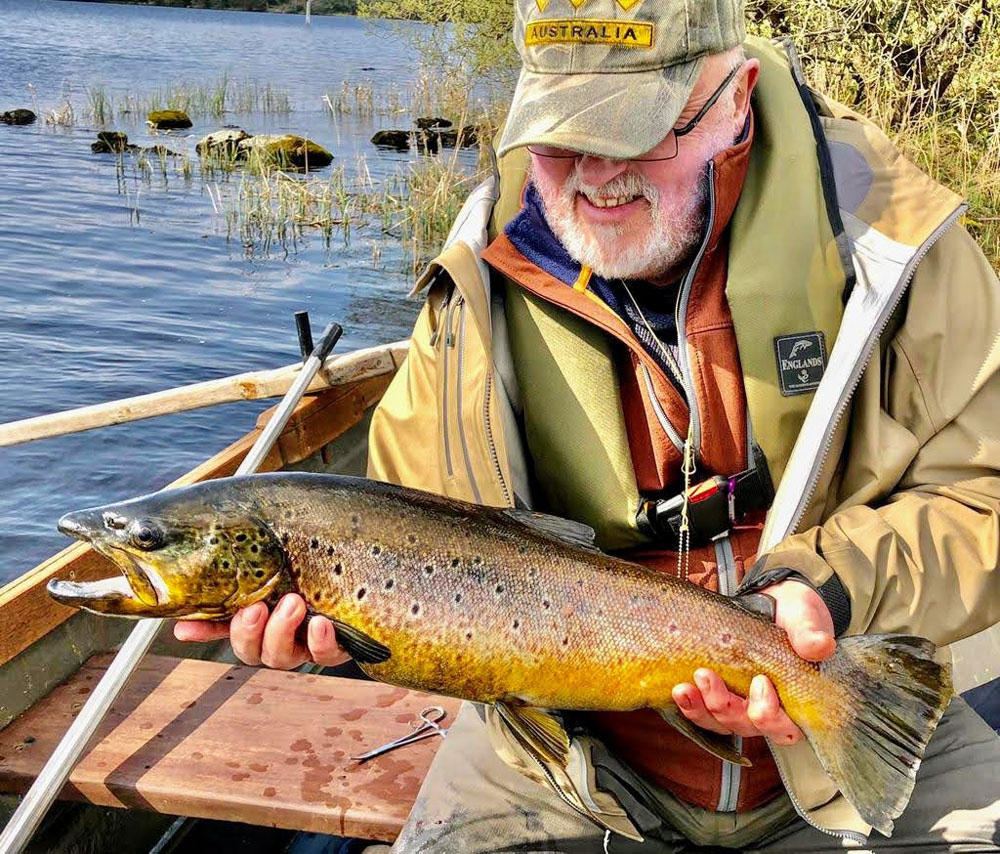
Many of my biggest and most exotic fish, by way of contrast, aren’t at all memorable. I only realised when drawing up my list that I’d forgotten many fish that seemed special at the time, especially saltwater game fish on charter boats. Maybe that’s because they’re really caught by the captains, and we anglers just wind them in?
Writing the book made me appreciate how much my fishing life was interwoven with my “other life” and it’s probably the same for most anglers to varying degrees. We can’t choose where or when we’re born and have little say in how we grow up, but we have a few more choices as we mature and experience new opportunities within widening worlds. Our other lives hugely influence our fishing lives, unless we devote our time entirely to fishing, but our fishing lives remain essential because they connect us to the natural world, even if many places we fish are highly artificial. Maybe that’s why I’ve most enjoyed fishing wild Irish and Scottish loughs, rugged New Zealand rivers and lovely, desolate oceans.
The early death of my father led to Mum taking me and my sisters to Dobbs Weir on the river Lea in Hertfordshire, to live near my grandparents. Grandad kick-started my fishing life and I grew up in a specimen hunting golden age during the post-war boom, with growing affluence and mobility to the mid-1970s (not that we had much money or a car).
Fishing ambitions weighed heavily in my early academic career, especially my university choice: to Southampton to fish the nearby Hampshire Avon for chub and barbel, and Glasgow to satisfy my burning desire to fish Loch Lomond for monster pike.
My “other” life largely determined my fishing opportunities and constraints for almost 40 years, with teaching and research jobs in Birmingham and London in the 1970s and Australia in the 1980s. I started a job at Ulster University in Derry only expecting to stay a couple of years, but I still live here 30 years later, happily married to Maeve who I met a couple of months after I’d arrived. My working life paid the mortgage, with enough pension to keep me fishing into old age, and some savings, though most have been spent on fishing.
My family and academic colleagues had little interest in fishing, apart from enjoying a fish or two for the table. Most of my best friends are anglers and fishing has been a thread running through our lives and friendships, not just our leisure activities but also our career and job choices, places to live and life partners. Some marriages ended badly due to divergent perspectives on fishing, and my most obsessed mates were only ever fit to live alone.
Few of my fishing mates considered that being an academic involved real work or believed my claim that sitting down in a nice quiet library and reading scholarly journals was an important part of my job. Most mocked the idea that going to academic conferences overseas, especially when combined with fishing trips, were anything other than holidays paid for by other people. OK, fair point.
My book is largely my story, but it also reflects the experiences of many others of my generation – the “baby boomers” – who lived and fished in the second half of the 20th century and the start of the 21st. We experienced huge economic, social, and political changes and the emergence of technologies barely imaginable in the 1950s. These changes affected our fishing lives, the environments where we fished, and who we knew as we passed along life’s journey.
We had opportunities that weren’t available to previous generations, witnessed the decline of many fish stocks but improvements in some others, so our fishing lifetimes were different from previous generations and those to come. We were the first generation where long-distance travel for fishing holidays became a realistic option for many people, rather than a tiny affluent minority.
My fishing life began in the distinctive circumstances of 1950s post-war Britain. The country was at peace, in the security of an emerging welfare state, but with its economy still recovering from a devastating war. Travel and communications were utterly different from today. Few families had cars or telephones. Most journeys were made on foot, bicycle, or public transport, and people mainly communicated face-to-face or by letter.
Summer holidays for most people were typically one week at the seaside. Nobody talked about global warming, and few if any expected the human population to treble by 2020 or anticipated mass cheap air travel and overseas holidays.
In the 1950s, most people only got their news from newspapers or radio, though TV was widespread by 1960. There were no mobile phones and no internet when I left home for university in 1966, coal mining and manufacturing industries were still major employers, and the UK and Ireland hadn’t joined the European Union. Car ownership grew rapidly in the 1960s, but even by 1970 only half of all British households had their own cars or vans.
The world of angling today reflects the many changes of the last 60 years, as did my fishing life. By the age of 15 I was a would-be “specimen hunter” of “coarse” fish, especially tench and carp, not then appreciating that the distinction between “coarse” and “game” fish was nonsense, reflecting a passing English class system imposed on unwitting fish. My early obsessions with roach, chub, barbel and pike in the 1960s, and carp madness in the 1970s, shifted to include sea angling in the 1970s, fly fishing for trout in the 1980s, and saltwater fly fishing more recently.
I’ve fished hard and often but generally haven’t taken it too seriously, though non-fishing family and friends may disagree. My youthful idea that one type of fishing was superior to another has long since been abandoned, and, like so many others before me, I find it slightly weird that people rank different types of fishing and types of fish.
I still enjoy many types of fishing, especially fly fishing for wild Irish brown trout, and that’s where my new Cadence CSM 10ft #7 enters the story. I got it last year after Stevie let me try one at the Derry & Strabane Angling Fair in April. It’s got the qualities that you’d want in a perfect lough boat fly fishing rod: all the power you’d expect in a 7-weight but beautifully light in the hand, great action, and a crisp recovery. It’s also very versatile and copes equally well with all line types, from full floaters through to fast sinkers.
I first used it successfully last year with a range of sinking lines for wet flies and streamers, especially my favourite team of three “Cat” flies developed by Bill Beck in Tasmania. They’re a type of minkie but tied using the fur from feral cats, which are fair game everywhere in Australia as they devastate small indigenous ground-dwelling birds and mammals. I usually tie my “Cat” flies here with micro squirrel zonker strips. They work just as well as the originals, especially my version of Bill’s “Green Machine” fished on the point fly anywhere that has a decent head of small perch. This Lough Erne 5-pounder certainly thought it was worth eating, as we had to reach right into its throat to remove the fly with forceps.
My Cadence 7-weight also performed beautifully with floating lines on Sheelin in April this year, both for sub-surface fishing with a team of epoxy buzzers and presenting dry balling buzzer imitations for fish like this lovely 4-pounder.
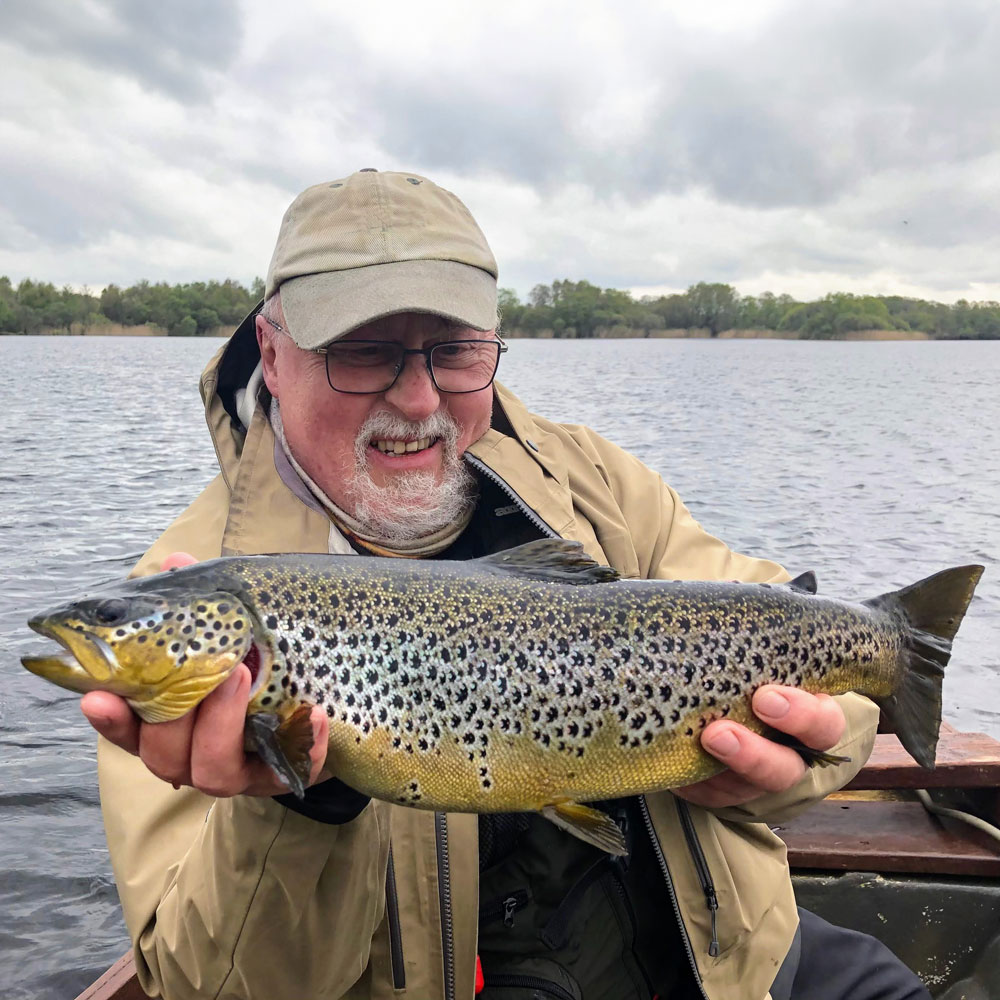
It’s fry time now in late August as I write on a wild and windy day, so I’m itching to get back out on a lough as soon as the winds drop a bit and get those cat flies working their magic. I haven’t tried the rod on my local rivers yet, but it’s certain to be a great single-handed rod for sea trout and grilse on the Strule or the Bush.
My book The Fish of a Lifetime is available at a modest cost from Amazon.

